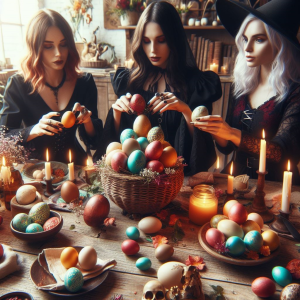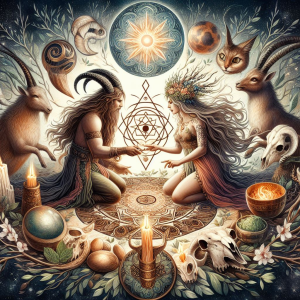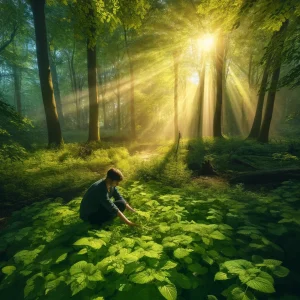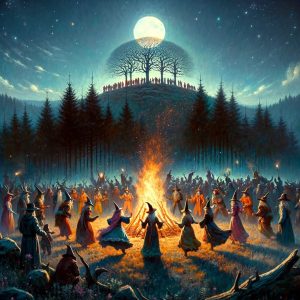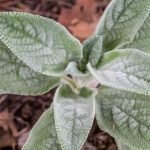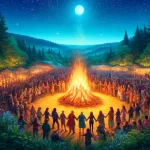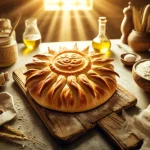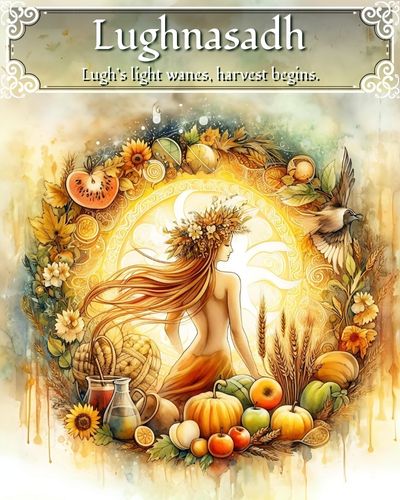
Approx. Reading time: About 10 Minutes

Introduction
A Dance of Light and Life, Ostara
As the earth emerges from its serene winter slumber, Ostara, a festival cherished during the vernal equinox around March 20th, orchestrates the enchanting ballet of light and life. In this sacred Pagan celebration, imbued with the essence of balance and fertility, we stand at the juncture where day and night intertwine in a harmonious dance, sharing an embrace of perfect equilibrium. It is a moment when the tangible promise of spring materializes, breathing life into the dormant landscape and infusing the air with the sweet anticipation of nature’s reawakening.

What is Ostara?
Ostara, a radiant celebration named after the Germanic goddess Eostre, unfurls its petals as a symbol of the triumphant ascendancy of light over darkness. Nestled around the vernal equinox, this enchanting festival heralds the lengthening of days and the gradual awakening of nature from its wintry repose. It’s a poignant juncture where the earth, infused with renewed vitality, readies itself to burst forth in vibrant hues of green and blossoms. Ostara invites us to partake in a joyous communion with this resurgent energy, acknowledging the eternal dance of light and darkness in the grand tapestry of existence.
History and Origins
Ostara’s historical tapestry is woven with threads of ancient traditions, entwined with the rich narratives of cultural celebrations marking the arrival of the spring equinox. At the heart of this festival is Eostre, the Anglo-Saxon goddess of dawn and fertility, her name whispered through the ages as a testament to the cyclical dance of life and nature.
The origins of Ostara trace back to pre-Christian times, where diverse cultures embraced the equinox as a moment of profound significance. Eostre, often associated with the rising sun and the fecundity of the earth, became a focal point for springtime festivities. Her name, infused with the promise of dawn and the resurgence of life, lent a poetic elegance to this celebration.
Symbols like eggs and hares, deeply embedded in Ostara’s iconography, carry echoes of ancient beliefs in rebirth and abundance. Eggs, potent with the potential of life within, symbolize the embryonic stage of the natural world’s renewal. Hares, renowned for their prolific reproductive capacities, embody the vitality and fertility intrinsic to this season of awakening. As Ostara unfolds, it beckons us to explore these ancient roots, where the earth’s rebirth and the goddess Eostre intertwine in a dance as old as time itself.
Embodied Spirits of Renewal: Deities Associated with Ostara
At the heart of Ostara’s spiritual tableau stands Eostre, a goddess whose very essence encapsulates the vibrant rebirth of the earth. Eostre, with her resplendent aura of dawn and fertility, becomes the focal point of reverence during this seasonal celebration. As the days lengthen and the earth awakens, she emerges as a symbol of the triumphant return of life, casting a benevolent gaze upon the burgeoning blooms and the promise of abundance.
Persephone, from the realms of Greek mythology, joins the chorus of deities honored during Ostara. Her myth, intricately linked with the changing seasons, sees her journeying between the underworld and the world above. As she returns to the surface, nature responds in kind, blossoming in a symphony of colors and life. Persephone embodies the cyclical nature of existence, and her presence during Ostara is a poignant reminder of life’s eternal dance.
In the verdant tapestry of nature, the Green Man finds his place of honor during Ostara. A symbol of untamed vitality, the Green Man represents the flourishing life force that courses through the earth. His visage, often depicted as a face adorned with foliage, speaks to the interconnectedness of all living things. As buds unfurl and the landscape transforms, the Green Man stands as a testament to the perpetual cycle of growth and renewal that defines the essence of Ostara. These deities, woven into the fabric of this celebration, beckon us to witness the divine choreography of spring’s awakening.
Traditions: A Tapestry of Symbolism
In the enchanting celebration of Ostara, traditions unfold like a vibrant tapestry, interwoven with profound symbolism that resonates with the essence of spring. Each custom, adorned with layers of meaning, paints a picture of renewal, fertility, and the rhythmic dance between light and darkness. As we delve into the tapestry of Ostara traditions, we discover the significance behind eggs, hares, and floral decorations, witnessing the timeless symbols that bridge the ancient past to the present, embodying the spirit of nature’s awakening.
- Eggs Fertility and Rebirth – Eggs, universally recognized symbols of fertility and rebirth, assume a prominent role in Ostara traditions. The act of decorating eggs transcends cultures, each pattern and color telling a unique story. The tradition of egg rolling, where participants roll decorated eggs down a hill, symbolizes the energetic rolling away of winter’s dormancy, welcoming the vibrant days of spring.
- Hares/Rabbits Prolific Breeding and Lunar Connection – Hares and rabbits, renowned for their prolific breeding, become powerful symbols of fertility during Ostara. Their connection to the moon adds another layer of symbolism, intertwining with lunar cycles and reflecting the cyclical nature of seasons. As these creatures bound into the landscape, they embody the joyful exuberance of life’s renewal.
- Floral Decorations Welcoming the Blossoming Season – Altars and homes come alive with the vibrant hues and fragrances of spring flowers during Ostara. Floral decorations, from daffodils to cherry blossoms, symbolize the beauty and vitality of the burgeoning season. The delicate petals and fresh aromas serve as reminders of nature’s awakening and the promise of life unfolding once again.
Modern Practices: A Blend of Old and New
In the kaleidoscope of modern Paganism, the celebration of Ostara manifests as a harmonious blend of ancient wisdom and contemporary spirituality. As the vernal equinox graces the Earth, modern practitioners engage in rituals that reflect a profound connection to the cyclical rhythms of nature. Lighting candles becomes a symbolic act, representing the delicate balance between light and darkness, as meditative reflections on equilibrium infuse the celebration with spiritual depth. Setting intentions for personal growth and renewal becomes a cherished tradition, echoing the ageless themes of Ostara. Moreover, many modern Pagans choose to honor their roots by incorporating traditional symbols like eggs and hares into their festivities, bridging the timeless past with the ever-evolving present. In this fusion of old and new practices, the celebration of Ostara becomes a living tapestry, weaving together threads of ancient reverence and contemporary spirituality.
Family Activities: Embracing Nature’s Renewal
Ostara presents a wonderful opportunity for families to come together and celebrate the awakening of the Earth after the slumber of winter. Engaging in various activities that connect them with the vibrant energy of the season, families create cherished memories and strengthen bonds.
- Egg Decorating Gather around the table with paints, markers, and stickers to transform ordinary eggs into works of art. This time-honored tradition not only sparks creativity but also symbolizes fertility and rebirth. Children delight in designing intricate patterns and vibrant colors, while parents share stories of the significance behind this ancient practice.
- Planting Seeds As the Earth awakens from its wintry hibernation, planting seeds becomes a meaningful activity for the whole family. Whether sowing seeds in a backyard garden or nurturing indoor plants, this hands-on experience fosters a connection with nature’s cycle of growth and renewal. Children eagerly watch as tiny seeds sprout into green shoots, learning valuable lessons about life and nurturing.
- Nature Walks Amidst the blossoming landscape, take a leisurely stroll with your loved ones and immerse yourselves in the beauty of the season. Explore local parks, nature reserves, or nearby trails, and observe the vibrant colors and fragrant blooms that herald the arrival of spring. Encourage children to collect fallen flowers, leaves, and other natural treasures, fostering a deeper appreciation for the wonders of the natural world.
Incorporating these family activities into your Ostara celebrations not only strengthens familial bonds but also instills a profound reverence for the cycles of nature and the interconnectedness of all living things.
The Symbolism of Eggs in Ostara Celebrations
As the earth begins to awaken from its wintry slumber, the arrival of Ostara heralds a time of renewal, fertility, and the vibrant promise of spring. At the heart of this ancient celebration lies a cherished tradition that transcends cultures and spans centuries: the symbolism of eggs. Universally recognized as symbols of fertility and rebirth, eggs take center stage during Ostara festivities, each delicately decorated shell telling its own unique story.
A Tradition Across Cultures
The practice of adorning eggs with vibrant colors and intricate patterns is a tradition that spans across cultures and civilizations. From ancient civilizations to modern-day societies, the egg has held profound symbolic significance. In ancient Egypt, eggs were buried in graves as symbols of rebirth and the afterlife. In Persia, decorated eggs were exchanged as gifts to celebrate the arrival of spring during the festival of Nowruz. Similarly, in Eastern European cultures, intricately painted eggs known as pysanky were crafted to symbolize protection, fertility, and the sun.
Renewal of Life and Nature
The symbolism of eggs in Ostara celebrations is deeply rooted in the renewal of life and the awakening of nature. As winter gives way to spring, the earth bursts forth with new life, and the egg serves as a powerful emblem of this transformation. The act of decorating eggs with vibrant colors and intricate patterns symbolizes the emergence of life from dormancy, the bursting forth of new possibilities, and the celebration of the cyclical nature of existence.
Egg Rolling: A Joyful Tradition
One of the most beloved customs associated with Ostara is the tradition of egg rolling. This joyful activity sees participants gathering atop hillsides to roll decorated eggs downhill. As the eggs cascade down the slopes, they symbolize the energetic rolling away of winter’s dormancy and the ushering in of the vibrant days of spring. This playful ritual embodies the spirit of Ostara, celebrating the renewal of life and the promise of new beginnings.
Heralding the Arrival of Spring
As the decorated eggs tumble down the hillsides, they herald the arrival of spring and the promise of new beginnings. The vibrant colors and intricate patterns adorning each egg serve as a testament to the beauty and diversity of life. In this moment of joy and celebration, participants are reminded of the cyclical nature of existence and the eternal cycle of renewal that defines the changing seasons.
The symbolism of eggs in Ostara celebrations serves as a powerful reminder of the eternal cycle of life, death, and rebirth. As we decorate eggs, roll them down hillsides, and celebrate the arrival of spring, we honor the profound interconnectedness of all living things and the enduring promise of renewal that accompanies the changing seasons.
The Symbolism of Hares/Rabbits in Ostara Celebrations
During Ostara, the celebration of the vernal equinox, nature awakens from its winter slumber, bursting forth with new life and vitality. Among the symbols that herald the arrival of spring, hares and rabbits occupy a prominent place, embodying the essence of fertility, abundance, and the cyclical nature of existence.
Prolific Breeding: Symbols of Fertility
Hares and rabbits are renowned for their prolific breeding habits, making them powerful symbols of fertility and renewal. In many cultures, these creatures have long been associated with the fecundity of the earth and the abundance of life. Their presence during Ostara celebrations serves as a potent reminder of the vitality and resilience of nature as it emerges from the dormancy of winter.
Lunar Connection: Intertwining with Lunar Cycles
In addition to their association with fertility, hares and rabbits also hold a significant connection to the moon. Throughout history, these creatures have been linked to lunar cycles, with their breeding patterns often mirroring the phases of the moon. This lunar connection adds another layer of symbolism to their presence during Ostara, underscoring the cyclical nature of seasons and the eternal dance of light and darkness.
Embodying Joyful Renewal
As hares and rabbits bound into the landscape during Ostara, they embody the joyful exuberance of life’s renewal. Their playful antics and boundless energy serve as a vibrant expression of the season’s vitality, inspiring awe, and wonder in those who witness their frolics. In their presence, we are reminded of the enduring cycles of nature and the eternal promise of renewal that accompanies the changing seasons.
Hares and rabbits play a vital role in Ostara celebrations, symbolizing the fertility, abundance, and cyclical nature of existence. As these creatures bound across the landscape, they remind us of the inexorable rhythms of nature and the eternal cycle of life, death, and rebirth. In their presence, we find solace and inspiration, knowing that with each passing season, life’s everlasting renewal is assured.
The Significance of Floral Decorations in Ostara Celebrations
As Ostara, the festival of the vernal equinox, unfolds, altars and homes alike are adorned with the vibrant colors and delicate fragrances of spring flowers. This tradition of floral decorations serves as a poignant expression of the beauty and vitality inherent in the burgeoning season, symbolizing the renewal of life and the promise of new beginnings.
A Tapestry of Spring Hues
Floral decorations during Ostara encompass a wide array of blossoms, each imbued with its own unique symbolism and significance. Daffodils, with their cheerful yellow blooms, herald the arrival of spring and the awakening of nature from its winter slumber. Cherry blossoms, revered for their ephemeral beauty, evoke a sense of transience and renewal, reminding us to cherish the fleeting moments of life’s blossoming.
Embracing Nature’s Awakening
The presence of spring flowers in Ostara celebrations serves as a tangible reminder of nature’s awakening and the cyclical rhythms of the seasons. As delicate petals unfurl and fresh aromas fill the air, we are invited to embrace the beauty and vitality of the burgeoning season, rejoicing in the boundless creativity of the natural world.
A Symbol of Hope and Renewal
Floral decorations not only beautify our surroundings but also carry profound symbolic significance. They symbolize hope, renewal, and the eternal cycle of life, death, and rebirth. In their presence, we find solace and inspiration, knowing that with each passing season, nature offers us the opportunity for growth, transformation, and spiritual renewal.
Floral decorations play a vital role in Ostara celebrations, symbolizing the beauty, vitality, and renewal inherent in the burgeoning season. As we adorn our altars and homes with spring flowers, we pay homage to the creative power of nature and the eternal cycle of life’s blossoming. In their delicate petals and fragrant aromas, we find solace and inspiration, rejoicing in the promise of new beginnings and the enduring beauty of the natural world.
Conclusion: A Rebirth of Spirit
In the symphony of nature’s awakening, Ostara emerges as a poignant reminder of the cyclical nature of life and the eternal dance of renewal. As we bask in the equinox energies, may we find harmony and balance within ourselves, resonating with the vibrant pulse of the season. With each blossom and each songbird’s trill, let us witness the profound transformation unfolding both in the world around us and within our own spirits. As Ostara envelops us in its embrace, may we embrace the potential for growth, joy, and vitality, blooming anew with each passing day.

